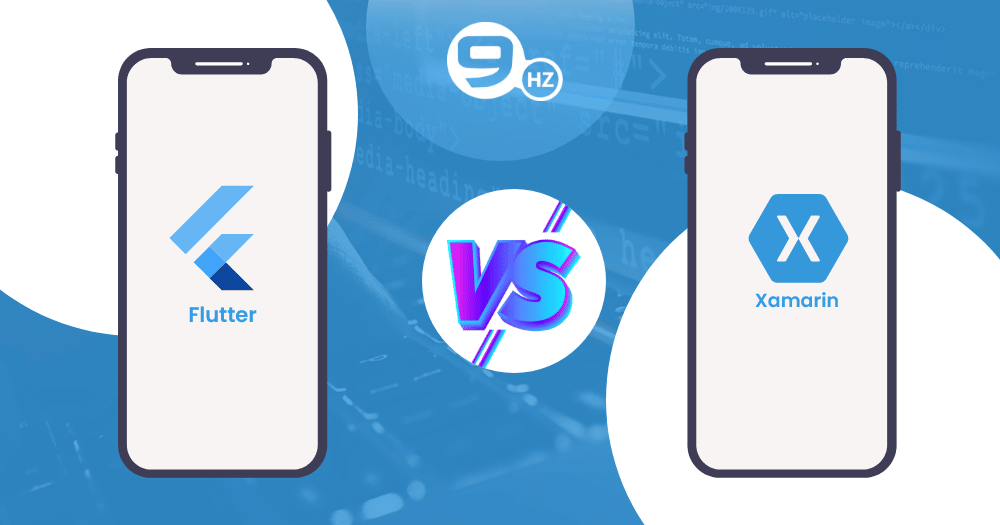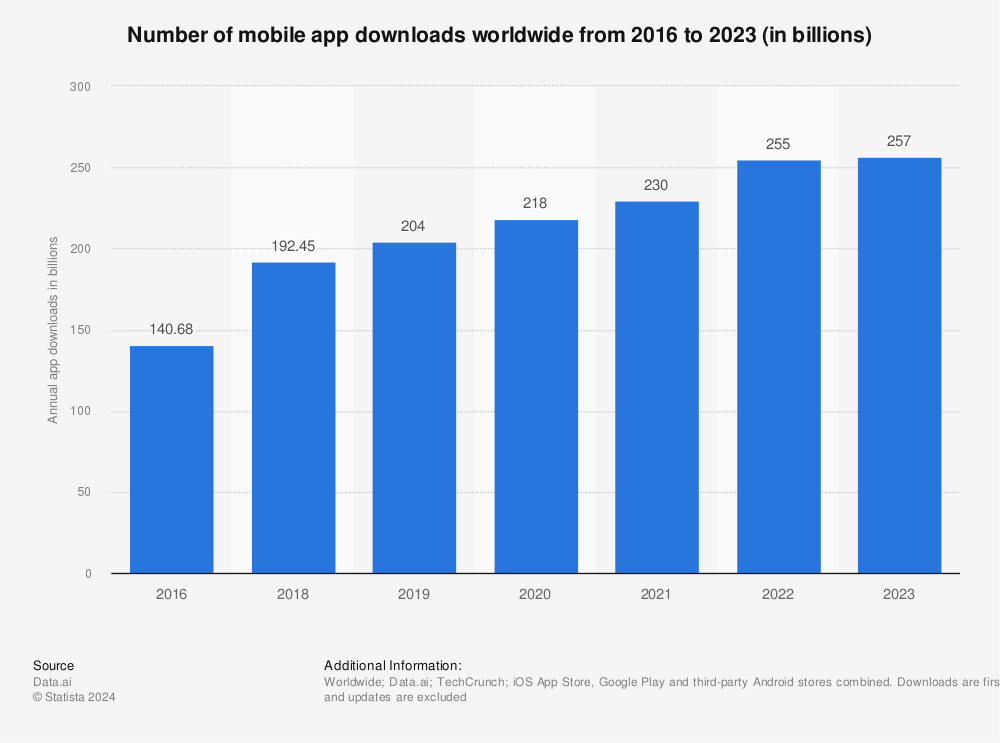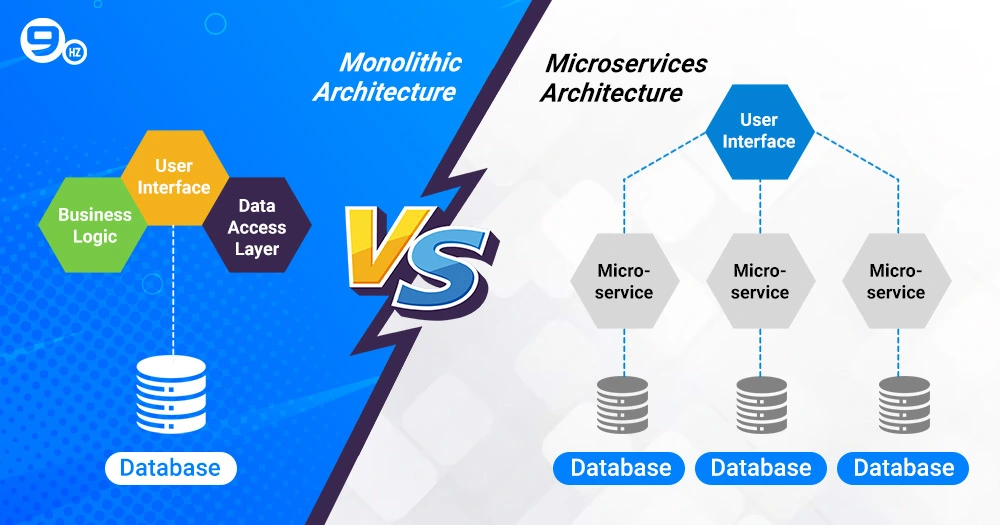Popularity of cross-platform apps has increased by 45% since 2015. Almost 1 million cross-platform apps were developed in the last three years. The popularity of native apps has reduced by almost half since the advent of smartphones in 2012. At present, it is essential that every app works smoothly on Android, iOS and Windows. Flutter is a popular cross-platform Framework developed by Google. On the other hand, Xamarin is a Popular mobile app development Framework that has been taken over by Microsoft.
So, both of these frameworks are the top contenders for the cross-platform app development services. In this article, we will compare both of these cross-platform application development frameworks. But first, understand cross-platform app development before moving on Xamarin vs Flutter. We provides best flutter application development services for your business needs.
What is Cross Platform Application Development?
Cross-platform app development is the process of creating mobile apps that can function on all mobile operating systems. According to Statista, 140.68 billion mobile apps were downloaded in 2016. This number has risen to 230 billion in 2021. This number is enough to justify the popularity of cross-platform applications over native applications. The major problem with native apps was that the code for one operating system could not be used on others. This resulted in an unnecessary waste of time and resources in the application development process. Now let us move on to our main topic of Xamarin vs Flutter.
Source: Statista
Xamarin vs Flutter: Key Differences
| Framework | Flutter | Xamarin |
|---|---|---|
| Initial Introduction | 2017 | 2011 |
| Owner | Microsoft | |
| Programming Language | Dart | C# |
| Compilation Process | AOT and Dart VM | I iOS AOT and Android AOT |
| Platforms supported | Android and iOS | Android, iOS and AWP |
| Compatibility of 3rd Party apps | Very High | Moderate |
| Community Support | High | Limited |
| Price | Free | Commercial version is paid |
| Popularity | High and increasing | High but reducing |
| Used by | Google, Tencent, BMW, eBay | Fox, BBVA, World Bank |
Xamarin and Flutter are the leaders in the cross-platform application Development Industry creating high-quality applications for many years now. These Frameworks have all the experience you need to create the most successful cross-platform apps. Before beginning our comprehensive comparison, let us take a detailed look into the basics of both these frameworks.
What is Flutter Framework?
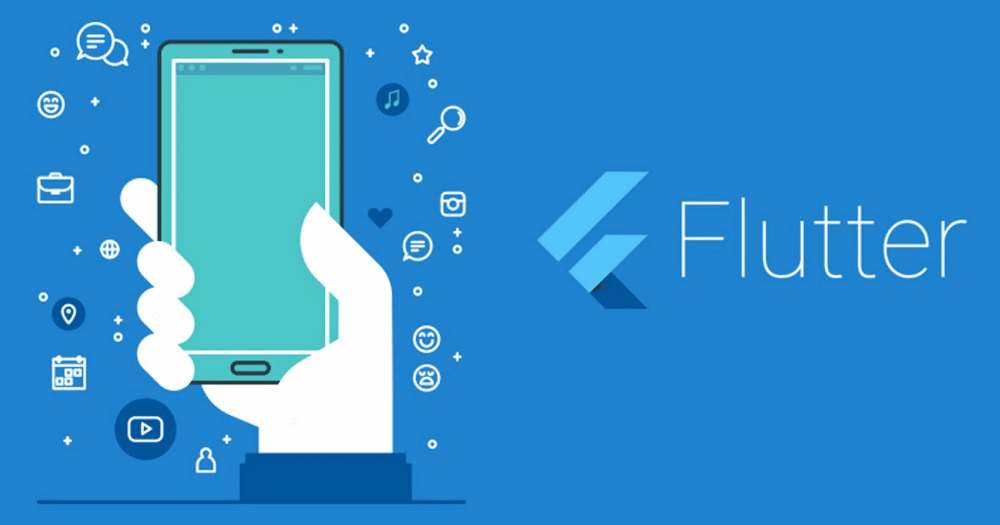
Flutter is a strong competitor compared to Xamarin. However, its unique features and progressive mindset have helped it to push back the oldest players in the segment. Flutter was released by Google in 2017. It was a part of the progressive development kit. Flutter combines a software development kit with a framework. Within a year of releasing the beta version, Google released the first stable version of Flutter. The progressive mindset of Flutter is clearly visible from the fact that it is already on version 1.22.
Over the past three years, many apps have been developed with flutter. The official Flutter community claims that there are almost 100,000 Flutter apps that are currently operational. Flutter works on the motto of “code once, deploy twice.” The re-rendering speed of flutter has helped it to gain a lot of attention. It is worth noting that other frameworks also support software re-rendering. However, none of them can match the speed of Flutter SDK.
Advantages of Flutter Framework
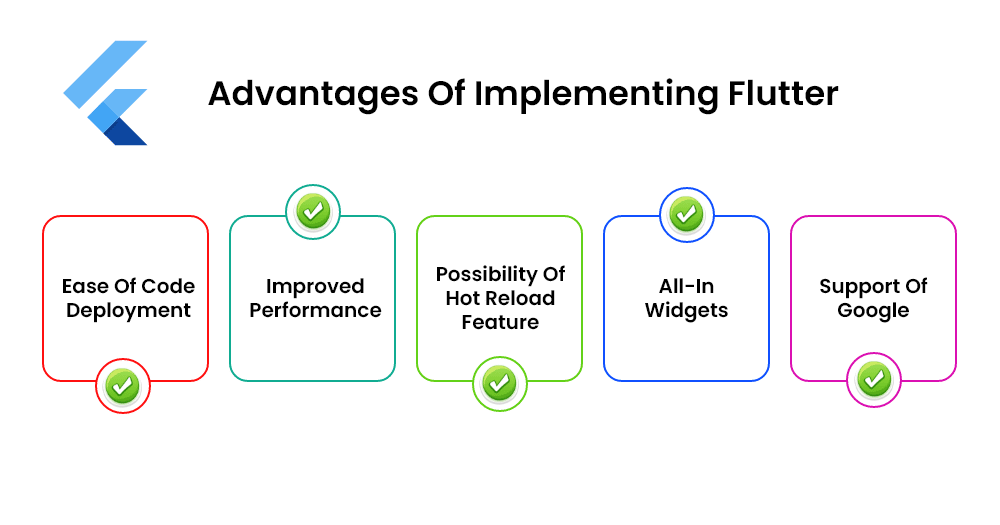
The advantages of Flutter are so immense that it is impossible to list all of them in one article. So, in this portion, we will take a brief look at some of the major ones:
1. Ease of Code Deployment
This feature helps the companies to reach a huge portion of the audience and improve the popularity of the application. It helped the developers to ensure that the application has favorable conditions for users of different operating systems. The single code base allows the developers to quickly adopt a new environment and start developing the required project.
2. Improved Performance
Dart cannot be termed as a simple programming language for developing applications. This is because by using the Dart language the developers can create applications with huge ergonomics and better performance. The power of Dart can easily be witnessed by its ability to compile apps into the native environment for Android or iOS.
3. Possibility of Hot Reload Feature
This is one of the most convenient features that every developer desires during the development phase. Using the hot reload feature, the developers can automatically forward every change in the code to the simulator or hardware in real-time. Therefore, it eliminates the hassle of restarting the application after every change and waiting for the launch process.
4. All-in Widgets
It is not only an advantage while using Flutter but also a treat to the human eye. This is because it is worth noticing a similar view of the application irrespective of the device, operating system or even the browser. Flutter helps the developers to eliminate the worry about the documentation and presentation process. Flutter is also famous all around the world for its wonderful support process.
5. Support of Google
The support of Google almost eliminates all worries regarding the reliability or quality of applications developed with Flutter. It also ensures that the application would be constantly updated to keep it capable of surviving in the competitive industry.
Certified Cross-Platform App Developer [Hire in 1 Hr]
Disadvantages of Flutter Framework
All the advantages of Flutter cannot overshadow the fact that it is still young and undergoing development. So let us take a quick look at some of the disadvantages the developers might have to face while using Flutter at this stage:
1. Huge Weight of the Application
The ease of access cannot overshadow the fact that applications developed with Flutter are quite large and resource exhaustive. So, it means that there is a high probability that the application will not function properly on low-end devices with lesser available memory. This factor can affect the reach of the application as only 20% of the user base has the latest flagship devices.
2. Limited Range of Libraries and Plugins
Due to its young age, Google Flutter does not have a wide range of libraries and plugins. Moreover, the available ones are also undergoing development and aren’t completed yet. However, Flutter allows you to choose the libraries that perform the functioning outside the application and implement it into the system.
3. Absence of Native APIs
At the current state Flutter does not have a lot of native APIs available for implementation. So, the developers must prepare themselves for invoking multiple additional packages into the Flutter ecosystem. At the same time, the developers must also remember that Flutter APIs are constantly evolving.
What is Xamarin Framework?
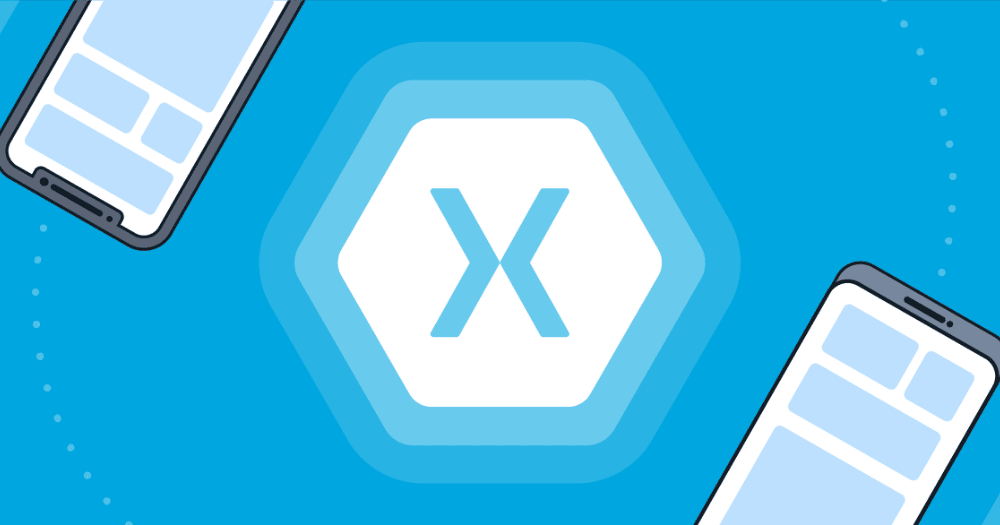
In case, the developers are wondering which Framework first started the process of cross-platform application development similar to native apps, then the answer is Xamarin. It was first developed in America in the year 2011. Then in 2016, Microsoft purchased this framework and integrated it with the Net. platform. The initial developing company for Xamarin was Mono.
In the present state, Xamarin has become a part of the visual studio, .NET and C# group. It was only a few months ago in December 2021 that Microsoft released a new version of Xamarin. It is called the Xamarin forms 5. There has been a little indignation among developers as Microsoft has revealed its plans of developing Xamarin on MAUI in the future.
A great gesture on the part of Microsoft is their willingness to work on tools and plugins to prevent extra burdens on companies and developers. Microsoft claims that over the past couple of updates, Xamarin Forms has undergone more than 60 integral and physical changes.
Advantages of Xamarin Framework
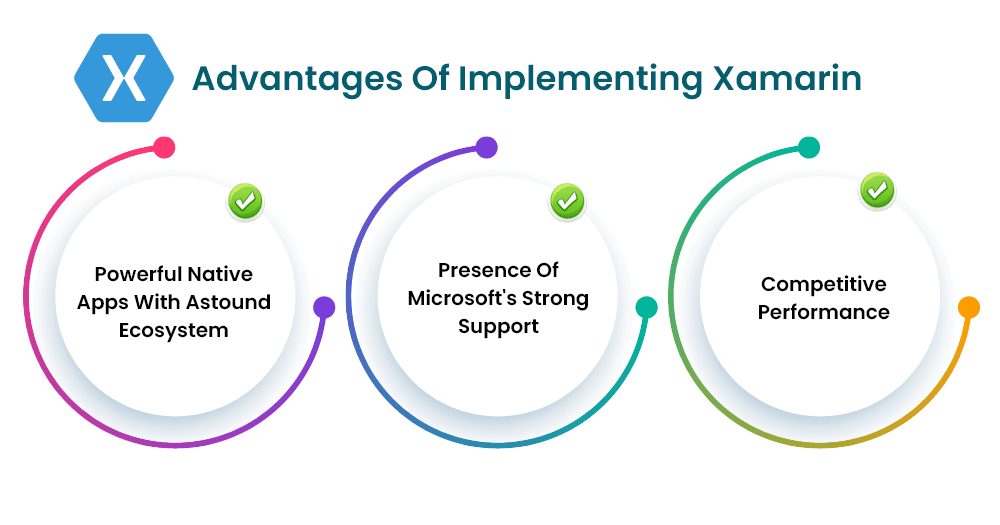
1. Powerful Native Apps with Astound Ecosystem
The power of C# and .NET Technologies are well known to almost all developers. Since these technologies will be driving the code development processes of Xamarin, so, we can easily guess how powerful the result will be. The app developed is also very flexible and offers a wide range of functionality.
2. Presence of Microsoft’s Strong Support
Microsoft and Google are probably two of the most powerful tech giants in the present industry. Both of them provide immense support to their cross-platform offspring Xamarin and Flutter respectively. So, the developers using Xamarin do not have to worry about the quality and dependency of the applications. The Xamarin developers can use the Xamarin Test Cloud to improve their application testing.
3. Competitive Performance
Xamarin has managed to optimize its performance for the high level of application. It also helps to accelerate the performance of the application with the help of its native compilation and hardware acceleration.
Disadvantages of Xamarin Frameworks
The fact that it is one of the oldest players in the cross-platform app Development Industry cannot overshadow the fact that it also has its share of shortcomings. So, let us take a quick look at some of the major ones:
Launch Your Cross-Platform App Now
1. The Weightage of the Apps is Unnecessarily Large
In case you need to add 5 MB of data to the application, the final compilation will end up getting 25 to 30 MB of additional data and may be unnecessary data. So, in this part, it is clear that Flutter is leading the way ahead of Xamarin. Xamarin still needs to optimize its data allocation processes.
2. Cost of Licensing and Developing Apps
The free version of Xamarin is only available to individual creators and small companies. The commercial Xamarin development requires a premium license and also the purchase of a Microsoft Visual Studio integrated development environment. The Visual Studio License starts from $499 and goes all the way up to $2999.
3. Limitations of User Experience
The developers must understand the limitations if they want to provide the best User experience to their customers. For instance, in iOS applications, there is a limitation in terms of generics. On the other hand, multiple platforms of Android suffer from a bandwidth limitation that cannot drive dynamic Android apps.
4. Presence of “Lock-in” Systems
The code that developers create will only hold its validity on the stack. NET. This means that the developer cannot reuse the code on other development stack.
5. The Lag During API Updates
With the release of SDK packages, the API update would take a long time. After the completion of the update, the developers have to restart the system for smooth functioning. Without the restart, the system might continue to lag as the API will not be synchronized with the latest SDK. Also read Flutter vs React Native
What are the Differences Between Flutter and Xamarin?
The best way to compare two different subjects is to create a standard list of both features based on certain parameters. Now let us follow this procedure for comparing Xamarin vs Flutter:
1. Programming Language
A developer can’t be accustomed to all programming languages. So, you must ensure that the framework of your choice is compatible with your preferred programming language.
Flutter:
Flutter uses the Dart programming language for writing the codes. Dart programming language is similar to the JavaScript programming language. So, the developers who are already accustomed to JavaScript will be able to quickly adapt to Dart.
Xamarin:
Xamarin uses the C# programming language. C# is a complex programming language. So, it can pose some obstacles for first-time users.
2. Architecture
Architecture is crucial to assemble all the components of a cross-platform application. It will also determine how easy it is to work with any framework. A proper architecture is also very critical to roll out critical updates in the future.
Flutter:
Flutter provides a simple architecture that is easy to understand for new developers. The separation of UI components in Flutter architecture helps the developers to focus on the major components.
Xamarin:
Xamarin uses a mono architecture that combines different components of the UI. Mono architecture also makes the UI complex for new developers.
3. Installation
The installation process is essential as it determines how much time the developers must invest before starting the testing process. Companies also need to determine whether the installation process for a framework requires any specialized training.
Flutter:
Flutter doesn’t require quite a long installation time and the developers can get started quickly. Google also provides comprehensive documentation to help in the installation process.
Xamarin:
Due to the complex installation process of Xamarin, new developers might face quite a bit of a struggle. Developers also do not find much technical support with the Xamarin installation process. It is almost impossible to work with Xamarin without having a strong link with the Visual Studio documentation.
4. API
API basically comprises all the tools and libraries that the developers can use during the application development process.
Flutter:
Flutter provides all the apps to create an interactive application. It also allows the developers to access third-party libraries to improve the quality of the application. Some of the features offered by Flutter are API access, testing, state management and navigation.
Xamarin:
Microsoft has taken the leading role to provide proper documentation and API support to Xamarin. Currently, the developer can use Xamarin to create apps for Android, iOS, Linux, Mac OS and Watch OS. Xamarin also has a massive library of components and modules to support the development process.
5. Components of the UI
User Interface Components are critical to ensure that the application is easily accessible and navigable. These components are one of the driving factors to improve user satisfaction.
Flutter:
All the UI components of Flutter are presented in a simple manner that makes it easy to access and implement. Developers can also use the built-in widgets to further improve the effectiveness of the UI.
Xamarin:
Xamarin uses a combined approach that sometimes might be confusing for developers who are not accustomed to this. For instance, the interactive components of the UI will be merged with the static components while using Xamarin.
6. Pricing
Pricing is an important factor to consider for comparing Flutter with Xamarin. This is because not all developers or companies can afford to invest thousands of dollars in the licensing process,
Flutter:
Flutter is an open-source cross-platform app development Framework that is available for free. There is no limitation on any of its components or features.
Xamarin:
Xamarin also is an open-source Framework but it has limitations in its commercial version. For using the commercial Xamarin forms, the developers will have to purchase a premium license. Currently, the Xamarin Business license costs about $999 yearly.
7. Capabilities of Testing
The modern software development industry demands the quick delivery of high-quality applications. So, cross-platform app developers cannot afford to waste time in complex development processes.
Flutter:
The developers will find it easy to test simple applications on Flutter due to its API structure. The Flutter modules also help the developers to create test prototypes. These prototypes show the practicality of the app before proceeding to the production phase.
Xamarin:
Complex and big applications can benefit from Xamarin due to its hardware acceleration. Xamarin helps the smooth testing of GPU-intensive games which include AAA titles like Apex Legends Mobile.
8. Documentation, Community and General Support
With the popularity of cross-platform app development, more and more developers are adopting it. So, it is very critical that the framework provides proper support to newcomers.
Flutter:
Flutter has a very interesting community of tech enthusiasts and rich documentation that is enough to support new developers. Moreover, it is continuously improving itself with new documentation and debugging methods.
Xamarin:
Xamarin also provides an interactive support and documentation process. However, its community support is quite limited. New developers won’t benefit much from the community in case they are stuck with something.
Making the Choice Between Flutter vs Xamarin
Now that we’ve finished discussing the major advantages and disadvantages of both Xamarin and Flutter, it is time to find an answer to the statement Xamarin vs Flutter. To simplify the decision-making process in Flutter vs Xamarin, let us now shift our focus to the key takeaways of both of the development frameworks:
- Flutter is more reliable if the developers have to create Complex apps which require lots of development and testing.
- In case your primary focus is the superfast development of the application then you can go for Flutter. The high-speed deployment of code seems to be one of the major features of Flutter in recent years.
- Flutter is popular in the application Development Industry as it helps the company easily hire experienced and talented employees.
- When it comes to hiring, companies will find that Flutter developers are readily available compared to Xamarin developers.
- The presence of powerful documentation is highly critical to ensure that the developers can utilize all the features of a framework. However, it is impossible to conclude on this point as Flutter is growing very rapidly.
Conclusion
Cross-platform application development is the update to the software development industry that all developers have been waiting for. The cross-platform app development business offers huge prospects for custom mobile app development agency to improve their position in the competitive application Development Industry. In the app development market, giant companies like Xamarin and Flutter are trying to provide everything at their disposal so that the developers can create the most interactive applications. You must remember that Xamarin does not have great community support.
The primary focus of this article is to spread awareness about the primary difference between xamarin and flutter. Understanding everything about these Frameworks is critical to answering about Flutter vs Xamarin. The developing companies should also remember that they have a key role in enlightening their developers about the same.
FAQs
1. Is Xamarin Faster Than Flutter?
Xamarin provides hardware acceleration. So, it provides better rendering speeds on complex apps.
2. Is Xamarin Free?
The individual version of Xamarin is free to use. However, the commercial version requires a license starting from $499 yearly.
3. What is a Cross-Platform App?
Cross-platform apps are those apps that can work on multiple operating systems without any issues.
4. What are Some examples of Cross-Platform Apps?
Some popular examples of cross-platform apps include Instagram, Bloomberg and Facebook.
5. Which Framework is Best For Cross-Platform App Development?
Depending on your testing needs the perfect framework may vary. However, Flutter and Xamarin are two of the most popular names.
Great Together!
